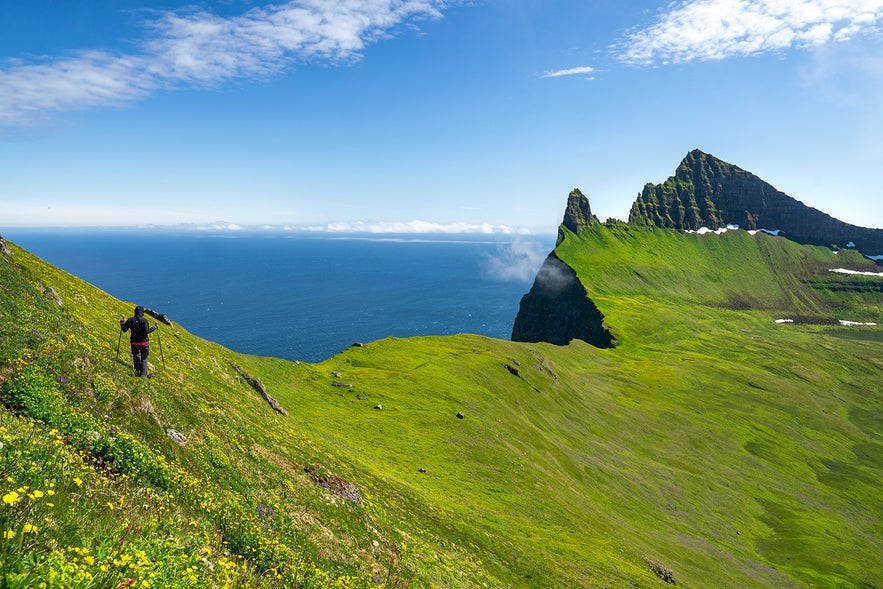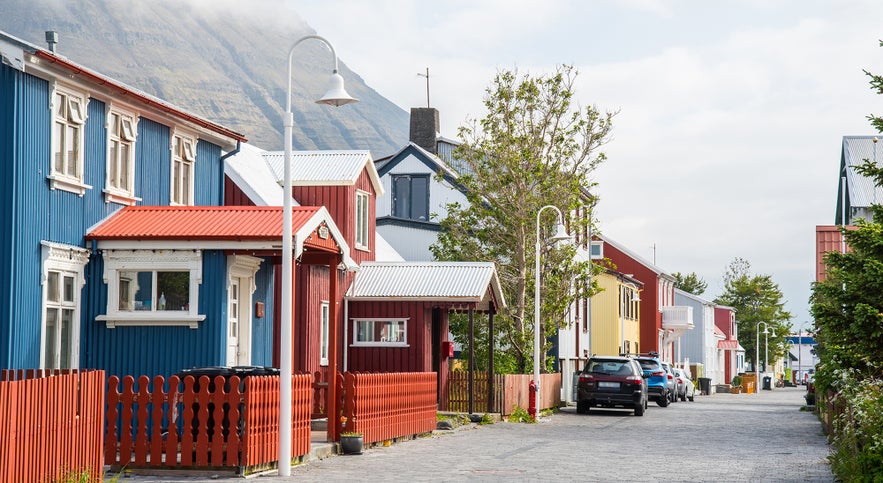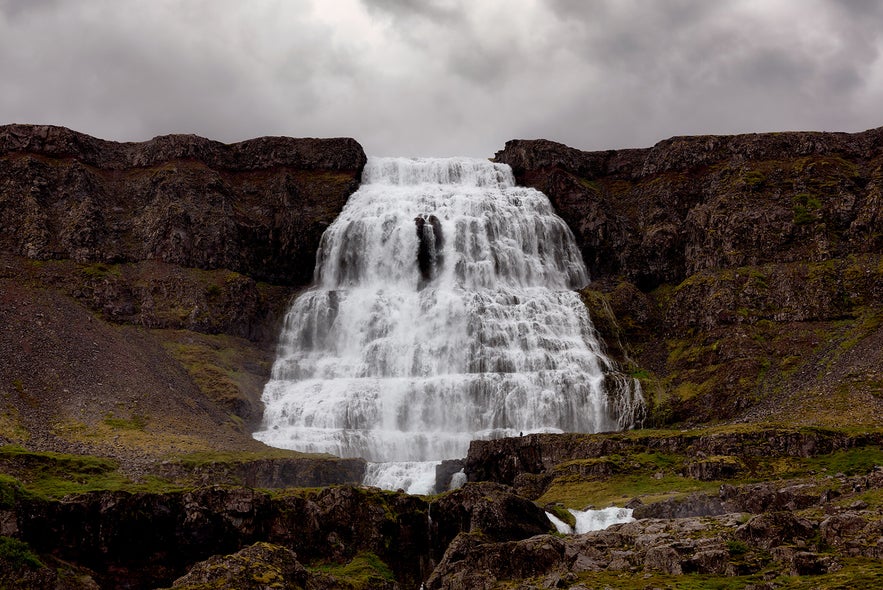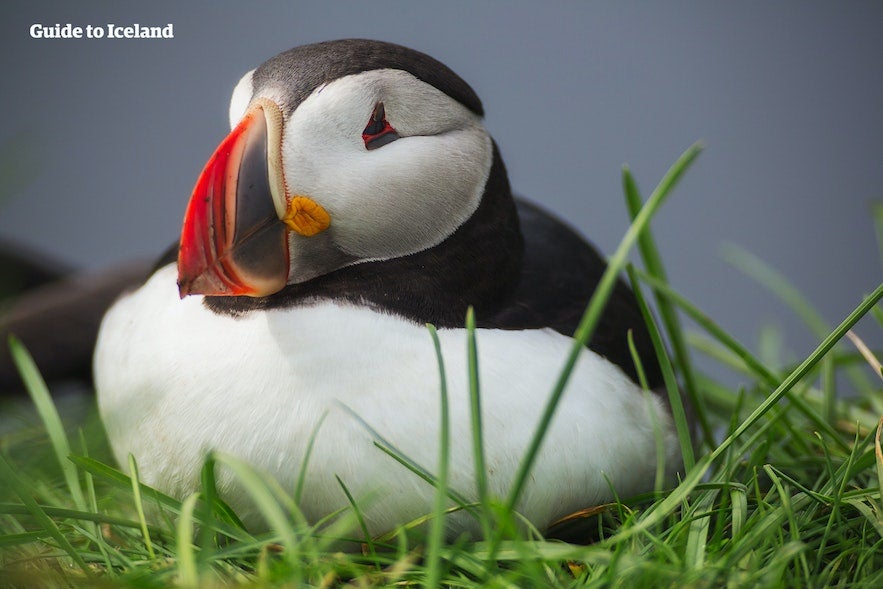
The Northern Westfjords is part of the Westfjords in Iceland, home to the Hornstrandir Nature Reserve and the town of Isafjordur. Because of its sparse population and remote location, the area has preserved its striking beauty and remains one of the most unspoiled areas in Iceland.
Like its counterparts like the Eastfjords and the South Coast, the Westfjords offers an experience for guests of all ages. Stretching over 8,599 square miles (22,271 square kilometers), the Westfjords is home to countless natural gems, dynamic wildlife, and captivating sceneries. If you're planning on visiting the beautiful region, make sure to book accommodation in the Westfjords ahead of time.
ทำไมคุณถึงวางใจในเนื้อหาของเราได้
Guide to Iceland คือแพลตฟอร์มท่องเที่ยวที่น่าเชื่อถือที่สุดในไอซ์แลนด์ ในแต่ละปี เราช่วยเหลือนักท่องเที่ยวหลายล้านคน เนื้อหาทั้งหมดของเราเขียนและตรวจสอบโดยผู้เชี่ยวชาญท้องถิ่นที่รู้จักไอซ์แลนด์อย่างลึกซึ้ง คุณจึงมั่นใจได้ว่าคำแนะนำด้านการท่องเที่ยวของเรามีความถูกต้อง ทันสมัย และเชื่อถือได้
What's in the Northern Westfjords?
The Northern Westfjords boast an array of natural attractions and cultural sites.
If there's one place in the area you shouldn't miss, it is the region's captivating nature reserve, Hornstrandir.
Established in 1975, the Hornstrandir Nature Reserve covers an area of 220 square miles (580 square kilometers) and is known for being a natural habitat for various Icelandic wildlife. The site is in the northwest part of Iceland and is the country's northernmost peninsula.
Being the least populated region outside of the Highlands, Hornstrandir has developed incredible flora and fauna over the past few decades.
Wildlife of the Hornstrandir Nature Reserve
 It is home to the Arctic fox, Iceland's only native land mammal. This fox species is considered elusive in other parts of the country. Typically, Arctic foxes feed on eggs and birds along the different cliff faces in Hornstrandir.
It is home to the Arctic fox, Iceland's only native land mammal. This fox species is considered elusive in other parts of the country. Typically, Arctic foxes feed on eggs and birds along the different cliff faces in Hornstrandir.
Considering the Arctic fox's rarity in the country, the Hornstrandir Nature Reserve instituted a hunting ban on the animal. Hence, these furry white animals are quite numerous here. It's also why Arctic foxes aren't afraid of people, as they don't see the latter as threatening their lives.
If you wish to learn more about Arctic foxes, check out the Arctic Fox Center in Sudavik, also in the Northern Westfjords. The place was built to promote the study and preservation of Arctic foxes while educating visitors about the species.
 Aside from the Arctic fox, the nature reserve also boasts a vibrant birdlife. The easternmost cliffs are breeding grounds for various species like black guillemots, razorbills, fulmars, Arctic terns, and adorable puffins, especially during summer.
Aside from the Arctic fox, the nature reserve also boasts a vibrant birdlife. The easternmost cliffs are breeding grounds for various species like black guillemots, razorbills, fulmars, Arctic terns, and adorable puffins, especially during summer.
The area's dynamic wildlife would only be complete with marine animals. The Hornstrandir Nature Reserve is one of the best spots in Iceland for whale watching.
These gentle creatures, led by the humpback whale, are often seen feeding from the shore. You may also encounter white-beaked dolphins and even orcas swimming in the waters.
When it comes to the nature reserve's physical features, it's rich in ferns and flowering plants, with over 260 species growing in the area. You'll also see green slopes, blue bays, glaciers, and tundra.
 You'll be treated to miles-long views of green valleys and pebbled shores, showcasing how well-preserved the Hornstrandir Nature Reserve is. Thundering waterfalls rolling down the mountains complement the majestic landscapes. Moreover, you'll see cliffs plummeting to the sea as the Drangajokull glacier bears witness.
You'll be treated to miles-long views of green valleys and pebbled shores, showcasing how well-preserved the Hornstrandir Nature Reserve is. Thundering waterfalls rolling down the mountains complement the majestic landscapes. Moreover, you'll see cliffs plummeting to the sea as the Drangajokull glacier bears witness.
You'll also find trails along Hornstrandir's unique terrains, making hiking one of the most popular outdoor activities in the area.
Despite its remote location, the Hornstrandir Nature Reserve is one of the most fascinating places you can visit in Iceland.

Photo from Wikimedia, Creative Commons, by Mickaël Delcey. No edits made.
These places help promote the country's geological balance. The Hornstrandir Nature Reserve protects particular plant and animal species, specific habitats, and geological formations.
The area also boosts Iceland's beauty and appeal, crucial for maintaining robust tourism. Considering its remote location and no permanent human residents, the Hornstrandir Nature Reserve can only be accessed through a ferry or charter boat from Isafjordur.
Isafjordur: The Largest Settlement
 Another notable spot in the Northern Westfjords is the town of Isafjordur, the region's largest settlement. Unlike the Hornstrandir Nature Reserve, which has been almost uninhabited since 1952, Isafjordur is home to about 2,600 people.
Another notable spot in the Northern Westfjords is the town of Isafjordur, the region's largest settlement. Unlike the Hornstrandir Nature Reserve, which has been almost uninhabited since 1952, Isafjordur is home to about 2,600 people.
Considered the capital of the Westfjords, Isafjordur is a picturesque town rich in cultural and outdoor recreational activities. It sits on the Skutulsfjordur fjord that belongs to the bigger Isafjardardjup fjord. As you explore the area, you'll see a majestic landscape featuring mountains complemented by the sea.
In the 16th century, Isafjordur became a center for fishing and trading. The town's natural harbor and proximity to the sea made it one of Iceland's largest fisheries.
The imprints of the town's unbreakable bond with marine life remain evident today. Isafjordur's residents still have a diet that mainly consists of seafood. Additionally, the town is home to Tjoruhusid, one of the best fish restaurants in Iceland.
Where to Stay in the Northern Westfjords
Visitors have different options when it comes to accommodations in Isafjordur. Country Hotel Heydalur is a beautiful farmhouse offering spacious rooms with essential amenities. Guests also have access to geothermal bathing and swimming facilities.
Meanwhile, Hotel Isafjordur Gamla is a good alternative if you're on a budget. Located near Isafjordur's harbor, the guesthouse is in a spot that's perfect for people looking to explore the northern Westfjords.
Where are the Northern Westfjords Located?
The Northern Westfjords are located in the northwest corner of Iceland. The Westfjords sit on the Denmark Strait, with the Greenland Sea to the west and the Northern Atlantic Ocean to the south.
What Makes the Westfjords Special?
 The Northern Westfjords are special for many reasons. These cover physical and cultural aspects contributing to the region's unique character.
The Northern Westfjords are special for many reasons. These cover physical and cultural aspects contributing to the region's unique character.
Cultural Heritage
The area represents the region's strong ties to fishing culture and heritage that helped shape the nation. The Northern Westfjords are home to small fishing villages and settlements that showcase the resilience of the local communities.
The region's proximity to rich fishing grounds translated into some of the finest regional cuisines featuring fresh catch from the waters. You'll also find museums that aim to educate people about the unbreakable bond between the region and the waters.
Aside from tasty marine-based cuisines, the Westfjords are known for their folklore and traditions. It is home to different museums focusing on unique and mystical subjects.
Spectacular Landscapes
 The Northern Westfjords are known for their breathtaking landscapes, including dramatic fjords, towering cliffs, lush valleys, and cascading waterfalls. The region's rugged terrain creates a stunning backdrop that attracts nature enthusiasts, photographers, and adventure seekers.
The Northern Westfjords are known for their breathtaking landscapes, including dramatic fjords, towering cliffs, lush valleys, and cascading waterfalls. The region's rugged terrain creates a stunning backdrop that attracts nature enthusiasts, photographers, and adventure seekers.
The area boasts a distinctive geography featuring narrow peninsulas and jagged coastlines that translate into a complex shoreline, unlike any other part of Iceland.
Remote and Untouched
Compared to other parts of Iceland, the Northern Westfjords are relatively remote and less visited than most parts of the country. This sense of seclusion and untouched wilderness adds to the region's charm and appeal for people seeking a more off-the-beaten-path experience. Therefore, it's a good idea to rent a 4x4 vehicle when visiting the region.
The region also has a diverse range of wildlife. The coastal areas and surrounding waters provide excellent birdwatching and marine life observation opportunities.
Outdoor Activities
The terrain and natural features of the Northern Westfjords offer various outdoor activities, such as hiking, camping, kayaking, and fishing. The diverse landscapes make it an ideal destination for adventurers and nature lovers.
Overall, the Northern Westfjords stand out due to their untouched nature, captivating landscapes, and a sense of isolation that allows visitors to truly connect with Iceland's rugged beauty. It's a destination that appeals to those who appreciate adventure, natural wonders, and rich culture.
How Can I Get to the Westfjords?
 Despite its remote location, the Westfjords can be reached in several ways. You can get to the region by joining a guided tour.
Despite its remote location, the Westfjords can be reached in several ways. You can get to the region by joining a guided tour.
Alternatively, you can rent a car and explore the region in a 14-day self-drive tour. The drive from Reykjavik to Isafjordur is about 282 miles (454 kilometers) long. A self-drive tour offers more flexibility, as you can stop anywhere you want to rest while gassing up your vehicle.
Other options include riding a plane via daily flights to Isafjordur or Bildudalur. If you wish to take public transport, you can board a bus from Reykjavik to Isafjordur. Take note that seasonal changes may affect the schedule of the bus rides.
Other Notable Attractions in the Westfjords
 Aside from Hornstrandir and Isafjordur, you'll also find other notable attractions in the Westfjords. The village of Holmavik is an interesting stop, especially if you wish to learn about Iceland's fascination with magic.
Aside from Hornstrandir and Isafjordur, you'll also find other notable attractions in the Westfjords. The village of Holmavik is an interesting stop, especially if you wish to learn about Iceland's fascination with magic.
Holmavik is home to the incredible Museum of Witchcraft and Sorcery. You'll find medieval items and bizarre artifacts connected to Icelandic magic here. You'll also learn how the early settlers used spells to keep bad luck and evil at bay.
Another Westfjords attraction you shouldn't miss is Dynjandi. This beautiful waterfall is around 328 feet (100 meters) tall, with cascades that widen as they reach the base. You'll also encounter smaller waterfalls as you walk toward the Dynjandi waterfall through a path with lush greenery.
Be sure to check out Latrabjarg, the longest birdwatching cliffs in the world. Thousands of birds, including the Atlantic puffin, nest on the cliffs throughout summer.

Another reason to see the cliffs is their historical significance. A daring rescue happened in Latrabjarg during the late 1940s after a British trawler capsized beneath the cliffs.
The accident happened at night, and if it were not for the locals who descended to the wreckage, none of the sailors would have survived.
Alternatively, you can learn about what life was like for Icelandic fishermen in the past by visiting the Osvor Maritime Museum. The place is a replica of a 19th-century Westfjords fishing station, complete with all the tools and equipment used by Icelandic fishermen.
Interestingly, the museum was built on the ruins of old fishing huts. The structure features stone and timber, just like in the olden days. There’s also a salt house and drying area for making the traditional Icelandic hardfiskur (dried stockfish).
The Westfjords is also where you’ll find the Raudasandur beach. It is located by the cliff and features unique white-reddish sand that separates it from most Icelandic beaches. It’s also home to hundreds of seals.
The beach is also known for the remnants of a farm where two notorious killers allegedly lived. The story behind these killers inspired the acclaimed novel “The Black Cliffs” by respected Icelandic author Gunnar Gunnarsson.









